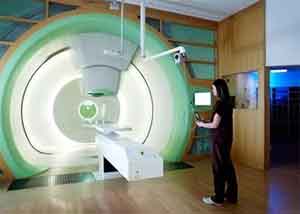- Home
- Editorial
- News
- Practice Guidelines
- Anesthesiology Guidelines
- Cancer Guidelines
- Cardiac Sciences Guidelines
- Critical Care Guidelines
- Dentistry Guidelines
- Dermatology Guidelines
- Diabetes and Endo Guidelines
- Diagnostics Guidelines
- ENT Guidelines
- Featured Practice Guidelines
- Gastroenterology Guidelines
- Geriatrics Guidelines
- Medicine Guidelines
- Nephrology Guidelines
- Neurosciences Guidelines
- Obs and Gynae Guidelines
- Ophthalmology Guidelines
- Orthopaedics Guidelines
- Paediatrics Guidelines
- Psychiatry Guidelines
- Pulmonology Guidelines
- Radiology Guidelines
- Surgery Guidelines
- Urology Guidelines
Proton therapy for prostate cancer offers higher survival rates and less complications

Proton therapy treatment for prostate cancer is associated with higher survival rates and decreased risk of complications compared to intensity-modulated radiation therapy (IMRT) according to a new study by researchers at the Northwestern Medicine Chicago Proton Center. The study is being presented at the 4th Annual Particle Therapy Co-Operative Group North-America (PTCOG-NA) Conference on October 25 in Chicago.
"This new evidence supports that proton therapy is at least as good as standard radiation therapy and may be significantly better in some areas, especially protecting normal tissue outside of the prostate," said the study's lead author William Hartsell, MD, medical director of the Northwestern Medicine Chicago Proton Center. "In addition, the evidence shows that proton therapy is advantageous for younger patients who we are most concerned about developing secondary cancers later in life."
Proton therapy uses protons heavy, positively charged atomic particles instead of the standard X-rays used in conventional radiation therapy. Protons deposit much of their energy, or dose, directly in the tumor and then stop, whereas conventional radiation continues to deposit the dose beyond the tumor.
Dr. Hartsell and colleagues reviewed the records of over 28,000 IMRT patients and 851 proton patients who received treatment from 2006-2012, using the Medicare and SEER (Surveillance, Epidemiology and End-Results Reporting) national databases. The proton patients were matched to IMRT patients in a 1:5 matching process using several parameters, including comorbidity index, cancer stage, tumor grade, adjuvant chemo/hormone therapy, age, zip code and ethnicity.
Using the matched patient cohort, the 5-year overall survival rate for proton therapy was 93.25% compared to 88.43% for IMRT. For the matched group of intermediate risk patients, the gap was slightly greater with a 5-year overall survival for proton therapy patients of 93.65% compared to 88.27% for IMRT.
The study also reviewed the incidence of complications and found significantly more patients with bladder, endocrine or "other" complications with IMRT compared to protons. In addition, there were greater numbers of patients with secondary malignancies with IMRT. 10.5% for IMRT compared to 6.1% for proton therapy at 5 years.
"This study is a significant update on the efficacy of proton therapy for prostate cancer. Many insurance companies are relying on outdated and incorrect data to determine coverage," said Dr. Hartsell.

Disclaimer: This site is primarily intended for healthcare professionals. Any content/information on this website does not replace the advice of medical and/or health professionals and should not be construed as medical/diagnostic advice/endorsement or prescription. Use of this site is subject to our terms of use, privacy policy, advertisement policy. © 2020 Minerva Medical Treatment Pvt Ltd